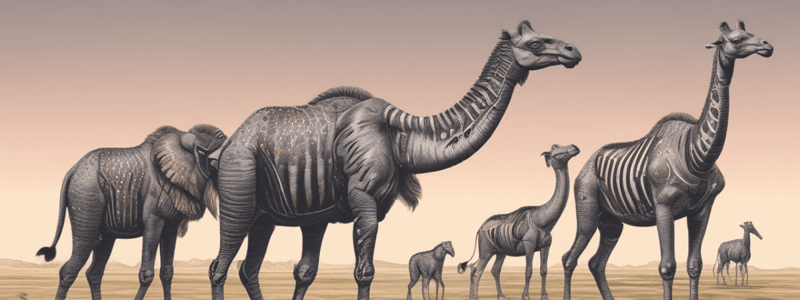Podcast
Questions and Answers
What is a necessary condition for the Hardy-Weinberg equilibrium to be maintained?
What is a necessary condition for the Hardy-Weinberg equilibrium to be maintained?
- Large populations and random mating (correct)
- Large populations and no mutation
- Random mating and mutation
- Diploidy and assortative mating
What is an example of a violation of the random mating assumption in the Hardy-Weinberg model?
What is an example of a violation of the random mating assumption in the Hardy-Weinberg model?
- Mutation and selection
- Assortative mating for height (correct)
- Genetic drift in small populations
- Inbreeding in Spanish royalty
What is the result of genetic drift in a small population?
What is the result of genetic drift in a small population?
- Loss of alleles and reduced diversity (correct)
- Genetic equilibrium
- No change in allele frequencies
- Increased genetic diversity
What is an example of a selective force that can change allele frequencies?
What is an example of a selective force that can change allele frequencies?
What is the equation that describes the Hardy-Weinberg equilibrium?
What is the equation that describes the Hardy-Weinberg equilibrium?
What is the primary reason why the genotype frequencies of a population do not agree with the Hardy-Weinberg assumptions?
What is the primary reason why the genotype frequencies of a population do not agree with the Hardy-Weinberg assumptions?
What is the consequence of a long tradition of inbreeding, as seen in the case of Carlos 2nd of Spain?
What is the consequence of a long tradition of inbreeding, as seen in the case of Carlos 2nd of Spain?
What is the reason why the Hardy-Weinberg equation does not equal 1 in a population?
What is the reason why the Hardy-Weinberg equation does not equal 1 in a population?
What is an example of a situation where the heterozygote has a selective advantage?
What is an example of a situation where the heterozygote has a selective advantage?
What is the result of the introduction of domestic cat alleles into the Scottish wildcat population?
What is the result of the introduction of domestic cat alleles into the Scottish wildcat population?
Flashcards are hidden until you start studying
Study Notes
Hardy-Weinberg Assumptions
- Dominance alone does not change allele frequencies over generations
- Large populations are assumed to maintain genetic equilibrium
- Random mating is assumed, with no inbreeding (e.g. Carlos 2nd of Spain, a product of inbreeding in Spanish royalty, breaks this assumption)
- Diploid organisms are assumed, with no mutation, selection, or migration
Assumptions Violations
- Assortative mating (e.g. humans mating for height, as seen in Van Kleef-Boltons' study) breaks the random mating assumption
- Small population size can lead to genetic drift, causing alleles to rise or fall in frequency, or even be lost from the population, resulting in a loss of diversity
- Mutation can change allele frequencies
- Migration (e.g. domestic cat genes into Scottish wildcat populations, introducing domestic cat alleles into most wildcats) can also alter allele frequencies
Natural Selection and Hardy-Weinberg Equilibrium
- If genotype frequencies do not agree with Hardy-Weinberg assumptions, it may indicate natural selection
- No selection is observed in cases like Sickle cell anaemia, where heterozygotes have an advantage, and recessive homozygotes often die young due to the lack of the genotype
- If p² + 2pq + q² ≠ 1, the population is not at Hardy-Weinberg equilibrium
Hardy-Weinberg Assumptions
- Dominance alone does not change allele frequencies over generations
- Large populations are assumed to maintain genetic equilibrium
- Random mating is assumed, with no inbreeding (e.g. Carlos 2nd of Spain, a product of inbreeding in Spanish royalty, breaks this assumption)
- Diploid organisms are assumed, with no mutation, selection, or migration
Assumptions Violations
- Assortative mating (e.g. humans mating for height, as seen in Van Kleef-Boltons' study) breaks the random mating assumption
- Small population size can lead to genetic drift, causing alleles to rise or fall in frequency, or even be lost from the population, resulting in a loss of diversity
- Mutation can change allele frequencies
- Migration (e.g. domestic cat genes into Scottish wildcat populations, introducing domestic cat alleles into most wildcats) can also alter allele frequencies
Natural Selection and Hardy-Weinberg Equilibrium
- If genotype frequencies do not agree with Hardy-Weinberg assumptions, it may indicate natural selection
- No selection is observed in cases like Sickle cell anaemia, where heterozygotes have an advantage, and recessive homozygotes often die young due to the lack of the genotype
- If p² + 2pq + q² ≠ 1, the population is not at Hardy-Weinberg equilibrium
Studying That Suits You
Use AI to generate personalized quizzes and flashcards to suit your learning preferences.




